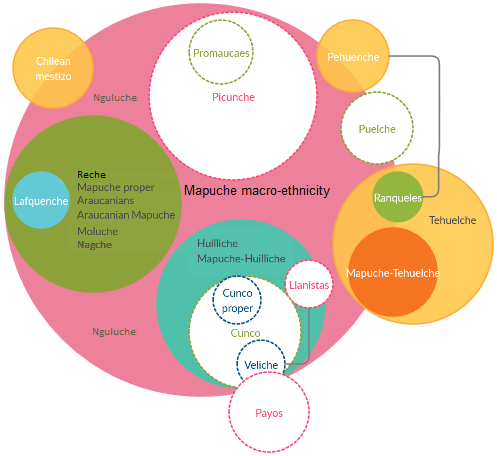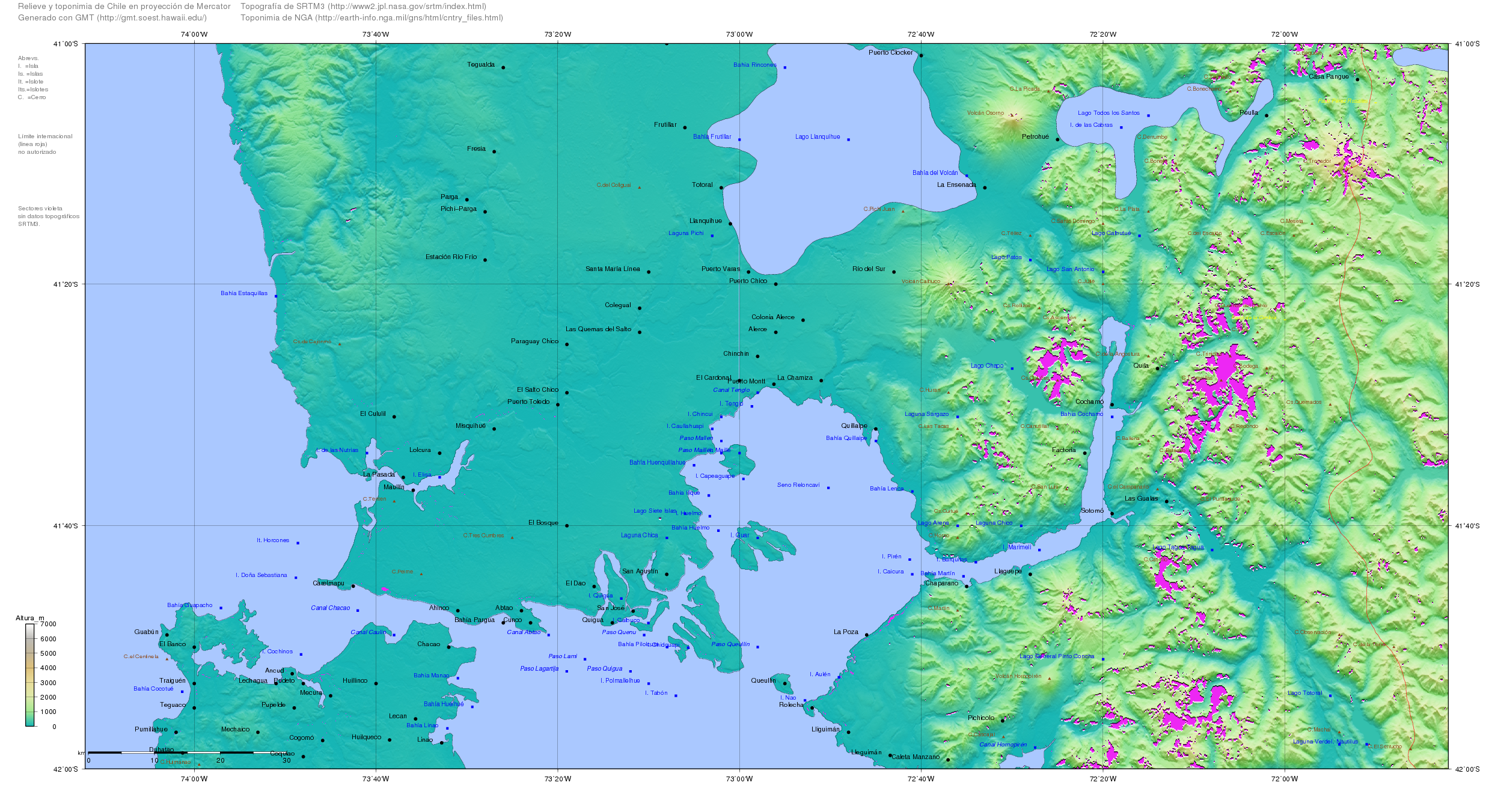|
Butalmapu
Butalmapu or Fütalmapu is the name in Mapudungun for "great land", which were one of the great confederations wherein the Mapuche people organized themselves in case of war. These confederations corresponded to the great geographic areas inhabited by the Mapuches in Chile. At the beginning of the conquest of Chile it is thought that there was a Butalmapu among the Picunche from the Limari River south to the vicinity of the Mataquito River that was headed by a Michimalonco. Also at the beginning of the conquest of Chile, a Moluche Butalmapu, ( name unknown), existed south of the Itata River and north of the Bio Bio River. It may have included the aillurehue of the Cauquenes north of the Itata, who occasionally fought with them against the Spanish in the sixteenth century and earlier against the Inca in the Battle of the Maule. Among the Moluche south of the Bio Bio River there were by the seventeenth century, three Butalmapu, that conformed with the main territorial identities o ... [...More Info...] [...Related Items...] OR: [Wikipedia] [Google] [Baidu] |
Aillarehue
Aillarehue or Ayllarehue (from the Mapudungun: ayllarewe/ayjarewe: "nine rehues"); a confederation of rehues or family-based units ( lof) that dominated a region or province. It was the old administrative and territorial division of the Mapuche, Huilliche and the extinct Picunche people. Aillarehue acted as a unit only on special festive, religious, political and especial military occasions. Several aillarehues formed the Butalmapu, the largest military and political organization of the Mapuche. Etymology Each Mapuche lof, levo or ''caví'' (lineage) celebrated its religious rituals at a unique rehue or rewe ("altar"), near the home of a local lonko, Ulmen or cacique, often the word ''rehue'' was used with the sense of party or clan ("I am from this rehue"), in a way similar to the old form of Christian administrative allegiance to parishes. Although aillarehue ment "nine altars" these confederations did not necessarily conform to this number of rehues. The name of man ... [...More Info...] [...Related Items...] OR: [Wikipedia] [Google] [Baidu] |
Mapudungun
Mapuche (, Mapuche & Spanish: , or Mapudungun; from ' 'land' and ' 'speak, speech') is an Araucanian language related to Huilliche spoken in south-central Chile and west-central Argentina by the Mapuche people (from ''mapu'' 'land' and ''che'' 'people'). It is also spelled Mapuzugun and Mapudungu. It was formerly known as Araucanian, the name given to the Mapuche by the Spaniards; the Mapuche avoid it as a remnant of Spanish colonialism. Mapudungun is not an official language of the countries Chile and Argentina, receiving virtually no government support throughout its history. However, since 2013, Mapuche, along with Spanish, has been granted the status of an official language by the local government of Galvarino, one of the many Communes of Chile. It is not used as a language of instruction in either country's educational system despite the Chilean government's commitment to provide full access to education in Mapuche areas in southern Chile. There is an ongoing politica ... [...More Info...] [...Related Items...] OR: [Wikipedia] [Google] [Baidu] |
Pehuenche
Pehuenche (or ''Pewenche'', people of the "pehuen" or "pewen" in Mapudungun) are an indigenous people of South America. They live in the Andes, primarily in present-day south central Chile and adjacent Argentina. Their name derives from their dependence for food on the seeds of the pehuen or monkey-puzzle tree (''Araucaria araucana)''. In the 16th century, the Pehuenche lived in the mountainous territory from approximately 34 degrees to 40 degrees south. Later they became Araucanized and partially merged with the Mapuche peoples. In the 21st century, they still retain some of their ancestral lands. Pehuenche groups participated in various armed conflicts in the 17th and 18th centuries, usually by "descending" from the mountains to the western lowlands of Chile. As such they attacked the Spanish around Maule River in 1657,Pinochet ''et al''. 1997, p. 82. the Mapuche in January 1767,Barros Arana, 1886, p. 236. and the Spanish of Isla del Laja on late 1769.Barros Arana, 1886, p. ... [...More Info...] [...Related Items...] OR: [Wikipedia] [Google] [Baidu] |
Mapuche Territorial Units
The Mapuche ( (Mapuche & Spanish: )) are a group of indigenous inhabitants of south-central Chile and southwestern Argentina, including parts of Patagonia. The collective term refers to a wide-ranging ethnicity composed of various groups who shared a common social, religious, and economic structure, as well as a common linguistic heritage as Mapudungun speakers. Their habitat once extended from Aconcagua Valley to Chiloé Archipelago and later spread eastward to Puelmapu, a land comprising part of the Argentine pampa and Patagonia. Today the collective group makes up over 80% of the indigenous peoples in Chile, and about 9% of the total Chilean population. The Mapuche are particularly concentrated in the Araucanía region. Many have migrated from rural areas to the cities of Santiago and Buenos Aires for economic opportunities. The Mapuche traditional economy is based on agriculture; their traditional social organization consists of extended families, under the direction of a ' ... [...More Info...] [...Related Items...] OR: [Wikipedia] [Google] [Baidu] |
Ricardo E
Ricardo is the Spanish and Portuguese cognate of the name Richard. It derived from Proto-Germanic ''*rīks'' 'king, ruler' + ''*harduz'' 'hard, brave'. It may be a given name, or a surname. People Given name *Ricardo de Araújo Pereira, Portuguese comedian * Ricardo Arjona, Guatemalan singer * Ricardo Arona, Brazilian mixed martial artist * Ricardo Ávila, Panamanian footballer *Ricardo Bralo, Argentine long-distance runner *Ricardo Bueno Fernández, Spanish politician *Ricardo Busquets, Puerto Rican swimmer *Ricardo Cardeno, Colombian triathlete * Ricardo Carvalho, Portuguese footballer *Ricardo Cortez, American actor * Ricardo Darín, Argentine actor *Ricardo (footballer, born 1980), full name Ricardo da Silva, Cape Verdean-Portuguese footballer *Ricardo Faty, Senegalese footballer *Ricardo Fischer, Brazilian basketball player *Ricardo Fortaleza, Filipino-Australian boxer *Ricardo Fuller, Jamaican football (soccer) player * Ricardo A. "Rick" Galindo, American politician *Ric ... [...More Info...] [...Related Items...] OR: [Wikipedia] [Google] [Baidu] |
Reloncaví Sound
Reloncaví Sound or ''Seno de Reloncaví'' is a body of water immediately south of Puerto Montt, a port city in the Los Lagos Region of Chile. It is the place where the Chilean Central Valley meets the Pacific Ocean. The Calbuco Archipelago comprises the islands in the sound, including Tenglo, Maillén, and Huar Islands. Puluqui Island and Queulín Island separate the sound from the Gulf of Ancud. The Carretera Austral runs along the eastern shore of the sound, but is interrupted in the area where the Reloncaví Estuary opens into this wide sound. Located in this same area is the Alerce Andino National Park Alerce Andino National Park is located in the Andes, in Los Lagos Region of Chile. This national park covers about 393 km2. It is bounded by the Reloncaví Estuary Reloncaví Estuary (Spanish: Esturario de Reloncaví, archaic: Sin Fo ..., home to ancient alerce trees. Chamiza Wetland makes up a segment of Relonvací Sound northern shore east of Puer ... [...More Info...] [...Related Items...] OR: [Wikipedia] [Google] [Baidu] |
Bueno River
Bueno River (Spanish: ''Río Bueno'') is a river in southern Chile. It originates in Ranco Lake and like most of Chile rivers it drains into the Pacific Ocean at the southern boundary of the Valdivian Coastal Reserve. Its lower flow forms the border between Osorno Province and Ranco Province. Traditionally it marks also the northern boundary of the indigenous Huilliche territory known as Futahuillimapu. The river passes through Río Bueno commune and city that takes name from the river. The major tributaries of the Bueno River are the Pilmaiquén River and the Rahue River, joining the river from the south. The former is the outlet of Puyehue Lake and the latter is the outlet of Rupanco Lake. Starting upstream the following settlements lie along the river: Puerto Nuevo at the source, Río Bueno, Trumao, Llancacura, and La Barra at the outflow in the ocean. The original Huilliche name for the river was ''Huenuleufu'', a combination of ''huenu'' "upper" and ''leufü ... [...More Info...] [...Related Items...] OR: [Wikipedia] [Google] [Baidu] |
Toltén River
Toltén River is a river located in the La Araucanía Region of Chile. It rises at Villarrica Lake, close to the city of the same name. Its major tributary is the Allipén River. From its confluence with the Allipén, the river follows a braided course. After flowing for about 123 km, the river reaches the Pacific Ocean The Pacific Ocean is the largest and deepest of Earth's five oceanic divisions. It extends from the Arctic Ocean in the north to the Southern Ocean (or, depending on definition, to Antarctica) in the south, and is bounded by the contine ... near '' Punta Nilhue'', where it is about 500 m wide. Cities and towns along the Toltén include: Villarrica, Pitrufquén, Teodoro Schmidt and Nueva Toltén. References External links Toltén River Map*Other coordinates: Rivers of Araucanía Region Rivers of Chile {{Chile-river-stub ... [...More Info...] [...Related Items...] OR: [Wikipedia] [Google] [Baidu] |
Cuncos
Cuncos or Juncos is a poorly known subgroup of Huilliche people native to coastal areas of southern Chile and the nearby inland. Mostly a historic term, Cuncos are chiefly known for their long-running conflict with the Spanish during the colonial era of Chilean history. Cuncos cultivated maize, potatoes and quinoa and raised chilihueques.Urbina 2009, p. 44. Their economy was complemented by travels during spring and summer to the coast where they gathered shellfish and hunted sea lions. They were said to live in large rukas.Alcamán 1997, p. 32. Cuncos were organized in small local chiefdoms forming a complex system intermarried families or clans with local allegiance.Alcamán 1997, p. 47. Ethnicity and identity The details of the identity of the Cuncos is not fully clear. José Bengoa defines "Cunco" as a category of indigenous Mapuche-Huilliche people in southern Chile used by the Spanish in colonial times.Bengoa 2000, p. 122. The Spanish referred to them as ''indios ... [...More Info...] [...Related Items...] OR: [Wikipedia] [Google] [Baidu] |
Huilliche
The Huilliche , Huiliche or Huilliche-Mapuche are the southern partiality of the Mapuche macroethnic group of Chile. Located in the Zona Sur, they inhabit both Futahuillimapu ("great land of the south") and, as the Cunco subgroup, the north half of Chiloé Island. The Huilliche are the principal indigenous people of those regions.Villalobos ''et al''. 1974, p. 49. According to Ricardo E. Latcham the term Huilliche started to be used in Spanish after the second founding of Valdivia in 1645, adopting the usage of the Mapuches of Araucanía for the southern Mapuche tribes. Huilliche means 'southerners' (Mapudungun ''willi'' 'south' and ''che'' 'people'.) A genetic study showed significant affinities between Huilliches and indigenous peoples east of the Andes, which suggests but does not prove a partial origin in present-day Argentina. During the 16th, 17th, and 18th centuries, the mainland Huilliche were generally successful at resisting Spanish encroachment. However, after th ... [...More Info...] [...Related Items...] OR: [Wikipedia] [Google] [Baidu] |
Francisco Núñez De Pineda Y Bascuñán
Francisco Núñez de Pineda y Bascuñán (1607–1682) was a Chilean writer and soldier. He was born in Chillán Viejo, Biobío Region, Chile. In 1629 he participated in an expedition to defeat the Mapuche, but, during the Battle of Las Cangrejeras, he was taken prisoner by the cacique Maulicán, who kept him captive for seven months. After being released, he rose through the ranks to become commander of the fort of Boroa in 1654, and he was eventually appointed Maestro de Campo in 1656 by Governor of Chile Pedro Porter Casanate and had an important role in the Spanish victory in Conuco and the relief of the fort of Boroa. From his experiences among the Mapuches, he wrote in 1673, the chronicle ''Cautiverio feliz y razón individual de las guerras dilatadas del reino de Chile'' (''Happy Captivity and Reason for the Prolonged Wars of the Kingdom of Chile''), which constitutes one of the most important and realistic descriptions of the customs of the Mapuche people, as we ... [...More Info...] [...Related Items...] OR: [Wikipedia] [Google] [Baidu] |


